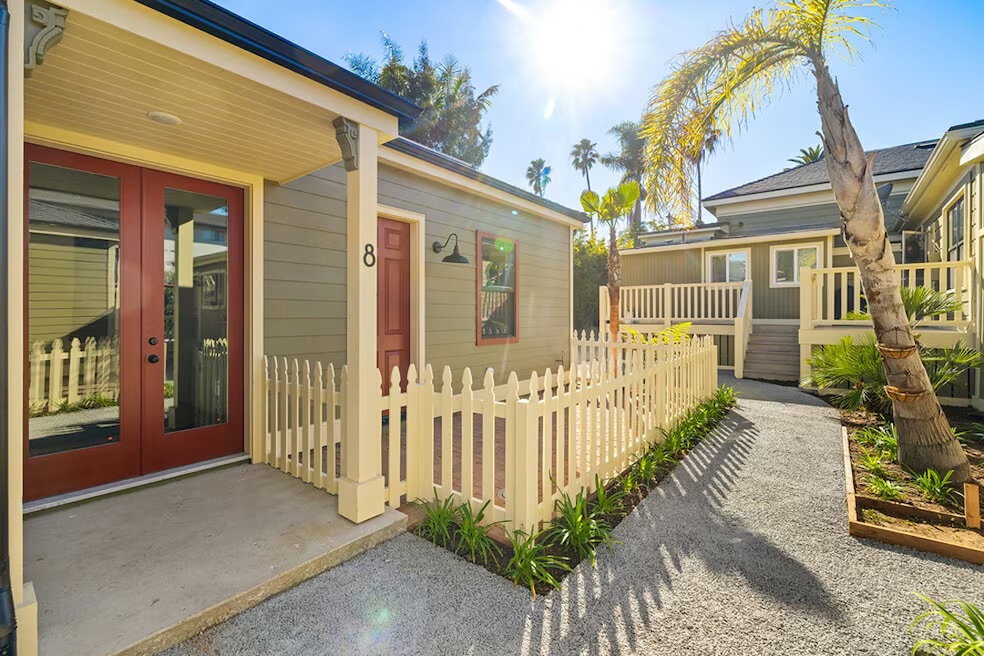They're known as "granny flats," "casitas," carriage houses, and in-law suites, but the official name is an accessory dwelling unit, or ADU.
An ADU is a secondary home that coexists with a primary residence on the same lot. It can be detached from your home as a standalone property or attached via a basement or attic. An ADU can also serve as a guest house, rental property or home office, depending on the homeowner.
Here's how these smaller homes — averaging 400 to 1,200 square feet — are becoming the go-to option for addressing affordability and housing density issues in communities nationwide.
ADUs fill the 'missing middle' gap in affordable housing
This term “missing middle” refers to housing inventory that exists between a standard single-family home and high-rise apartments or penthouses. Missing middle housing developments are often small and consist of two to six house-sized dwellings in walkable residential neighborhoods. Missing middle homes are designed to provide attainable housing options within existing communities, eliminating the need for large-scale redevelopment.
Missing middle housing types traditionally include, but aren’t limited to, side-by-side duplexes, stacked duplexes, triplexes, stacked fourplexes or townhouses. But developers are turning to ADUs as a cost-effective alternative. “They expand supply in places near jobs and schools without large rezones, which helps with availability and affordability over time,” said Whitney Hill, co-founder and CEO of SnapADU, a San Diego-based firm.
The idea is gaining momentum across the country. In Colorado, Gov. Jared Polis issued an executive order in August to nudge local governments into approving affordable housing options like ADUs. Before the order, ADU construction was blocked in many municipalities.
Can I use an ADU as my primary home?
In some states, you can use an ADU as a primary dwelling, although many homeowners use them as residential additions. In California, for example, owners can build and rent ADUs on a property without living on it themselves. Certain counties in Florida also passed new regulations allowing ADUs to be sold separately from the primary home.
Other states, such as Washington and Oregon, are loosening owner-occupancy requirements and allowing separate sales and condo-style ownership of ADUs, which is mutually beneficial for real estate investors, developers and consumers who need affordable housing.
“As more jurisdictions allow separate sale of ADUs, they will also open new ownership paths for units of a more affordable size than many larger homes,” Hill said.
Can you finance an ADU construction project?
Yes, you can finance an ADU — but there’s a caveat. Since an ADU isn't a full-sized home, you can't use a traditional mortgage. Instead, most consumers use a home equity line of credit or a fixed-rate second mortgage to finance their ADU projects. “Some lenders offer construction or renovation loans and a few [construction-to-permanent] products,” Hill said.
How much does it cost to build an ADU?
Builders price ADUs based on square footage. The average price per square foot for an ADU ranges between $150 and $600, depending on the location, construction type, materials and other factors.
For a 400-square-foot property, the prices can range from $60,000 to $240,000. Comparatively, prices for a 1,200-square-foot property range from $180,000 to $720,000.
What can go wrong: ADU buyers often overlook other costly elements beyond the base price. “It’s common to have $60,000 to $100,000 plus all costs beyond the building itself,” Hill said. These elements include feasibility and design studies, property reports, construction documents, permits and city fees, site work and utilities — including electrical services, sewage, and waterline connections.
“Ground yourself in real numbers,” Hill added. “Online ballparks are rarely all-in. There’s often $80,000 to $150,000 in site, utility and permit costs beyond the building itself.” The best way to obtain an accurate price is to conduct a feasibility study with a builder that outlines specific costs.
What should prospective ADU buyers think about?
Your first step should be figuring out why you want to build an ADU, Hill said. Is it for rental income or resale value? Or are you building a dwelling for aging parents? Whatever your ADU story is, your purpose will ultimately drive other decisions such as design, budget and layout. You aren't just building another dwelling; you're laying the foundation for a legacy.
After establishing a budget, think about customization. “Borrow from proven plans and layouts,” Hill said. Designing an ADU is about function and livability, above all else. An ADU builder can show you previous projects and floor plans that you can incorporate into your design. Remember, adding an ADU involves more than simply remodeling your home. Treat the project as a complex mini-home build.
Pro tip: Before you start designing, research the regulations in your area. Reach out to your city's zoning and planning department and submit an inquiry for information that could impact your ADU's design.
